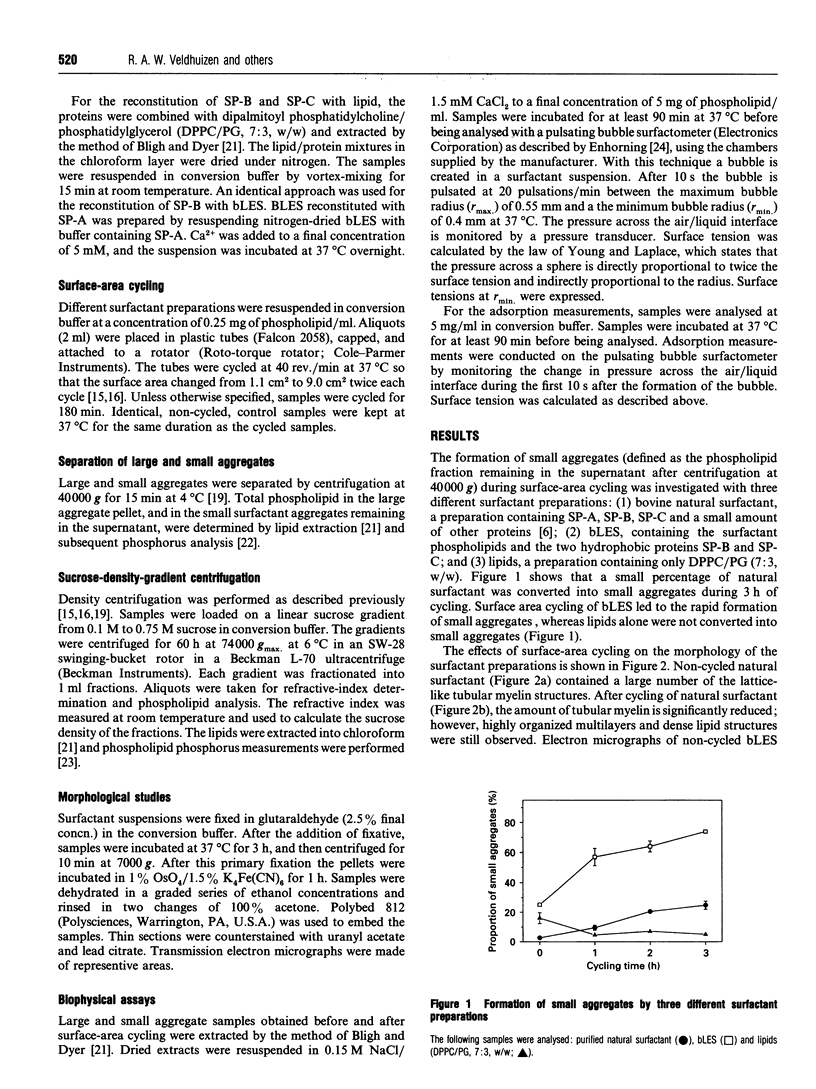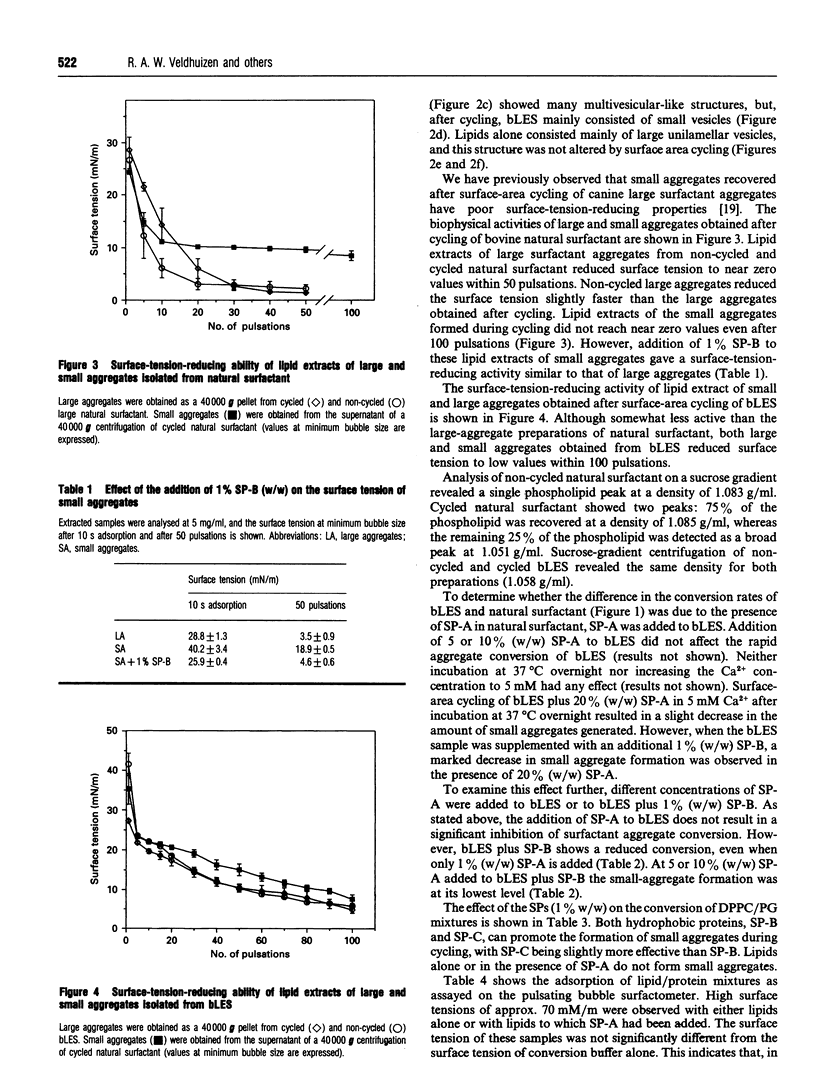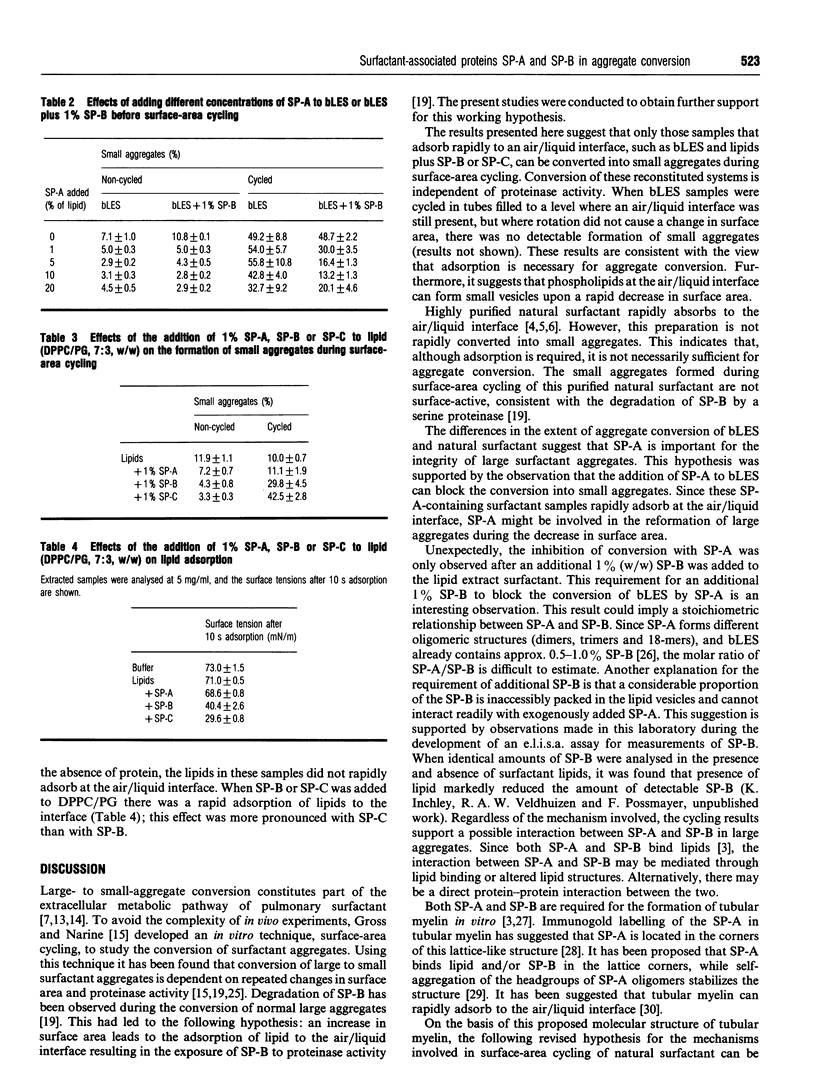Abstract
Surface-area cycling is an in vitro procedure for the conversion of large into small surfactant aggregates. In this procedure a tube containing a surfactant suspension is rotated end-over-end at 37 degrees C so that the surface area of the suspension changes twice each cycle. We have utilized this method to study the mechanisms involved in aggregate conversion. Several different surfactant preparations were analysed: (1) bovine natural surfactant, a sucrose-gradient-purified material containing surfactant phospholipid and surfactant-associated proteins (SP-) SP-A, SP-B and SP-C; (2) bovine lipid-extract surfactant, which contains the surfactant phospholipids and SP-B and SP-C; (3) mixtures of dipalmitoyl phosphatidylcholine and phosphatidylglycerol (7:3, w/w) reconstituted with one or more surfactant proteins. Aggregate conversion was measured by phosphorus analysis of a 40,000 g supernatant (small aggregate) and pellet (large aggregates) before and after surface-area cycling. Surface-area cycling of lipid extract surfactant or lipids plus SP-B or SP-C resulted in rapid aggregate conversion. Lipids alone were not converted. Only a small percentage of purified natural surfactant was converted into small aggregates. Addition of SP-A to lipid extract surfactant could inhibit aggregate conversion of this material, but this was only observed when an additional 1% (w/w) of SP-B was added to the lipid extract. It is concluded that SP-A is important for large-aggregate integrity. It appears that SP-A acts in conjunction with SP-B. The presence of SP-B and/or SP-C is required for aggregate conversion; it is proposed that this reflects the necessity for lipid adsorption in aggregate conversion.
Full text
PDF





Images in this article
Selected References
These references are in PubMed. This may not be the complete list of references from this article.
- BLIGH E. G., DYER W. J. A rapid method of total lipid extraction and purification. Can J Biochem Physiol. 1959 Aug;37(8):911–917. doi: 10.1139/o59-099. [DOI] [PubMed] [Google Scholar]
- Baritussio A., Bellina L., Carraro R., Rossi A., Enzi G., Magoon M. W., Mussini I. Heterogeneity of alveolar surfactant in the rabbit: composition, morphology, and labelling of subfractions isolated by centrifugation of lung lavage. Eur J Clin Invest. 1984 Feb;14(1):24–29. doi: 10.1111/j.1365-2362.1984.tb00699.x. [DOI] [PubMed] [Google Scholar]
- Chung J., Yu S. H., Whitsett J. A., Harding P. G., Possmayer F. Effect of surfactant-associated protein-A (SP-A) on the activity of lipid extract surfactant. Biochim Biophys Acta. 1989 Apr 26;1002(3):348–358. doi: 10.1016/0005-2760(89)90349-4. [DOI] [PubMed] [Google Scholar]
- Cockshutt A. M., Weitz J., Possmayer F. Pulmonary surfactant-associated protein A enhances the surface activity of lipid extract surfactant and reverses inhibition by blood proteins in vitro. Biochemistry. 1990 Sep 11;29(36):8424–8429. doi: 10.1021/bi00488a032. [DOI] [PubMed] [Google Scholar]
- Curstedt T., Jörnvall H., Robertson B., Bergman T., Berggren P. Two hydrophobic low-molecular-mass protein fractions of pulmonary surfactant. Characterization and biophysical activity. Eur J Biochem. 1987 Oct 15;168(2):255–262. doi: 10.1111/j.1432-1033.1987.tb13414.x. [DOI] [PubMed] [Google Scholar]
- Enhorning G. Pulsating bubble technique for evaluating pulmonary surfactant. J Appl Physiol Respir Environ Exerc Physiol. 1977 Aug;43(2):198–203. doi: 10.1152/jappl.1977.43.2.198. [DOI] [PubMed] [Google Scholar]
- Gregory T. J., Longmore W. J., Moxley M. A., Whitsett J. A., Reed C. R., Fowler A. A., 3rd, Hudson L. D., Maunder R. J., Crim C., Hyers T. M. Surfactant chemical composition and biophysical activity in acute respiratory distress syndrome. J Clin Invest. 1991 Dec;88(6):1976–1981. doi: 10.1172/JCI115523. [DOI] [PMC free article] [PubMed] [Google Scholar]
- Gross N. J. Inhibition of surfactant subtype convertase in radiation model of adult respiratory distress syndrome. Am J Physiol. 1991 Apr;260(4 Pt 1):L311–L317. doi: 10.1152/ajplung.1991.260.4.L311. [DOI] [PubMed] [Google Scholar]
- Gross N. J., Narine K. R. Surfactant subtypes of mice: metabolic relationships and conversion in vitro. J Appl Physiol (1985) 1989 Jul;67(1):414–421. doi: 10.1152/jappl.1989.67.1.414. [DOI] [PubMed] [Google Scholar]
- Gross N. J., Schultz R. M. Serine proteinase requirement for the extra-cellular metabolism of pulmonary surfactant. Biochim Biophys Acta. 1990 May 22;1044(2):222–230. doi: 10.1016/0005-2760(90)90306-i. [DOI] [PubMed] [Google Scholar]
- Gross N. J. Surfactant subtypes in experimental lung damage: radiation pneumonitis. Am J Physiol. 1991 Apr;260(4 Pt 1):L302–L310. doi: 10.1152/ajplung.1991.260.4.L302. [DOI] [PubMed] [Google Scholar]
- Haagsman H. P., Hawgood S., Sargeant T., Buckley D., White R. T., Drickamer K., Benson B. J. The major lung surfactant protein, SP 28-36, is a calcium-dependent, carbohydrate-binding protein. J Biol Chem. 1987 Oct 15;262(29):13877–13880. [PubMed] [Google Scholar]
- Hawgood S., Shiffer K. Structures and properties of the surfactant-associated proteins. Annu Rev Physiol. 1991;53:375–394. doi: 10.1146/annurev.ph.53.030191.002111. [DOI] [PubMed] [Google Scholar]
- Higuchi R., Lewis J., Ikegami M. In vitro conversion of surfactant subtypes is altered in alveolar surfactant isolated from injured lungs. Am Rev Respir Dis. 1992 Jun;145(6):1416–1420. doi: 10.1164/ajrccm/145.6.1416. [DOI] [PubMed] [Google Scholar]
- Kuroki Y., Shiratori M., Ogasawara Y., Tsuzuki A., Akino T. Characterization of pulmonary surfactant protein D: its copurification with lipids. Biochim Biophys Acta. 1991 Nov 5;1086(2):185–190. doi: 10.1016/0005-2760(91)90006-4. [DOI] [PubMed] [Google Scholar]
- Lee C. T., Fein A. M., Lippmann M., Holtzman H., Kimbel P., Weinbaum G. Elastolytic activity in pulmonary lavage fluid from patients with adult respiratory-distress syndrome. N Engl J Med. 1981 Jan 22;304(4):192–196. doi: 10.1056/NEJM198101223040402. [DOI] [PubMed] [Google Scholar]
- Lewis J. F., Ikegami M., Jobe A. H. Altered surfactant function and metabolism in rabbits with acute lung injury. J Appl Physiol (1985) 1990 Dec;69(6):2303–2310. doi: 10.1152/jappl.1990.69.6.2303. [DOI] [PubMed] [Google Scholar]
- Magoon M. W., Wright J. R., Baritussio A., Williams M. C., Goerke J., Benson B. J., Hamilton R. L., Clements J. A. Subfractionation of lung surfactant. Implications for metabolism and surface activity. Biochim Biophys Acta. 1983 Jan 7;750(1):18–31. doi: 10.1016/0005-2760(83)90200-x. [DOI] [PubMed] [Google Scholar]
- McGuire W. W., Spragg R. G., Cohen A. B., Cochrane C. G. Studies on the pathogenesis of the adult respiratory distress syndrome. J Clin Invest. 1982 Mar;69(3):543–553. doi: 10.1172/JCI110480. [DOI] [PMC free article] [PubMed] [Google Scholar]
- Possmayer F. A proposed nomenclature for pulmonary surfactant-associated proteins. Am Rev Respir Dis. 1988 Oct;138(4):990–998. doi: 10.1164/ajrccm/138.4.990. [DOI] [PubMed] [Google Scholar]
- Rouser G., Fkeischer S., Yamamoto A. Two dimensional then layer chromatographic separation of polar lipids and determination of phospholipids by phosphorus analysis of spots. Lipids. 1970 May;5(5):494–496. doi: 10.1007/BF02531316. [DOI] [PubMed] [Google Scholar]
- Schürch S., Possmayer F., Cheng S., Cockshutt A. M. Pulmonary SP-A enhances adsorption and appears to induce surface sorting of lipid extract surfactant. Am J Physiol. 1992 Aug;263(2 Pt 1):L210–L218. doi: 10.1152/ajplung.1992.263.2.L210. [DOI] [PubMed] [Google Scholar]
- Suzuki Y., Fujita Y., Kogishi K. Reconstitution of tubular myelin from synthetic lipids and proteins associated with pig pulmonary surfactant. Am Rev Respir Dis. 1989 Jul;140(1):75–81. doi: 10.1164/ajrccm/140.1.75. [DOI] [PubMed] [Google Scholar]
- Veldhuizen R. A., Inchley K., Hearn S. A., Lewis J. F., Possmayer F. Degradation of surfactant-associated protein B (SP-B) during in vitro conversion of large to small surfactant aggregates. Biochem J. 1993 Oct 1;295(Pt 1):141–147. doi: 10.1042/bj2950141. [DOI] [PMC free article] [PubMed] [Google Scholar]
- Veldhuizen R. A., Lee J., Sandler D., Hull W., Whitsett J. A., Lewis J., Possmayer F., Novick R. J. Alterations in pulmonary surfactant composition and activity after experimental lung transplantation. Am Rev Respir Dis. 1993 Jul;148(1):208–215. doi: 10.1164/ajrccm/148.1.208. [DOI] [PubMed] [Google Scholar]
- Voorhout W. F., Veenendaal T., Haagsman H. P., Verkleij A. J., van Golde L. M., Geuze H. J. Surfactant protein A is localized at the corners of the pulmonary tubular myelin lattice. J Histochem Cytochem. 1991 Oct;39(10):1331–1336. doi: 10.1177/39.10.1940306. [DOI] [PubMed] [Google Scholar]
- Williams M. C., Hawgood S., Hamilton R. L. Changes in lipid structure produced by surfactant proteins SP-A, SP-B, and SP-C. Am J Respir Cell Mol Biol. 1991 Jul;5(1):41–50. doi: 10.1165/ajrcmb/5.1.41. [DOI] [PubMed] [Google Scholar]
- Wright J. R., Clements J. A. Metabolism and turnover of lung surfactant. Am Rev Respir Dis. 1987 Aug;136(2):426–444. doi: 10.1164/ajrccm/136.2.426. [DOI] [PubMed] [Google Scholar]
- Yu S. H., Chung W., Olafson R. W., Harding P. G., Possmayer F. Characterization of the small hydrophobic proteins associated with pulmonary surfactant. Biochim Biophys Acta. 1987 Oct 17;921(3):437–448. doi: 10.1016/0005-2760(87)90070-1. [DOI] [PubMed] [Google Scholar]
- Yu S. H., Possmayer F. Adsorption, compression and stability of surface films from natural, lipid extract and reconstituted pulmonary surfactants. Biochim Biophys Acta. 1993 Apr 23;1167(3):264–271. doi: 10.1016/0005-2760(93)90228-2. [DOI] [PubMed] [Google Scholar]
- Yu S. H., Possmayer F. Effect of pulmonary surfactant protein B (SP-B) and calcium on phospholipid adsorption and squeeze-out of phosphatidylglycerol from binary phospholipid monolayers containing dipalmitoylphosphatidylcholine. Biochim Biophys Acta. 1992 Jun 5;1126(1):26–34. doi: 10.1016/0005-2760(92)90212-e. [DOI] [PubMed] [Google Scholar]
- Yu S., Harding P. G., Smith N., Possmayer F. Bovine pulmonary surfactant: chemical composition and physical properties. Lipids. 1983 Aug;18(8):522–529. doi: 10.1007/BF02535391. [DOI] [PubMed] [Google Scholar]
- van Iwaarden F., Welmers B., Verhoef J., Haagsman H. P., van Golde L. M. Pulmonary surfactant protein A enhances the host-defense mechanism of rat alveolar macrophages. Am J Respir Cell Mol Biol. 1990 Jan;2(1):91–98. doi: 10.1165/ajrcmb/2.1.91. [DOI] [PubMed] [Google Scholar]



